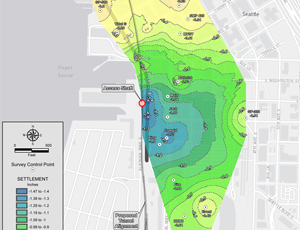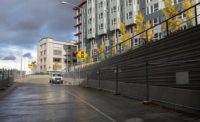
Differential settlement of more than an inch has temporarily shut down efforts on the already-stalled Alaskan Way Viaduct project under downtown Seattle. Excavation had been underway on an access pit that was designed to repair "Bertha," the stuck tunnel-boring machine (TBM), as crews continue to monitor the movement on surrounding buildings.
The 57.5-ft-dia machine has been stuck since December 2013, just over 1,000 ft into its 1.7-mile route under downtown Seattle as part of an effort to replace the aging viaduct after settlement was first detected a month earlier (ENR 2/24 p. 21).
Todd Trepanier, Washington state Dept. of Transportation's project administrator for the Alaskan Way program, told the Seattle City Council that the most recent monitoring found no new settlement since it was first recognized.
Robert "Red" Robinson, an independent geotechnical consultant on the project and vice president at Seattle-based Shannon & Wilson, says the most likely cause of the settlement came from the deepwater pump plan designed to keep the access pit dry. That plan pulled millions of gallons of water from a large underground aquifer.
"All of a sudden, it looks like we have this settlement," Trepanier says, referring to the data received on Nov. 24. "We don't know exactly when that occurred. It kind of coincides over the time they started pumping the deepwater wells."
"The amount of drawdown, 100 feet or so—that amount of dewatering changes the buoyancy of soils," Robinson told the Seattle City Council. "As we take water out of the ground, it depressurizes the aquifer and compresses the soil a little bit. The upper portions [of the soil] are getting compressed and changed."
But even with the 1.4 in. of settling near the access pit and on the viaduct, Lynn Peterson, the state's secretary of transportation, says there was no damage or risk to the viaduct, which never closed.Trepanier says the team has found no structural damage to the roughly 30 Pioneer Square buildings, which sit in the immediate vicinity of the settling.
Of the 20 buildings initially surveyed, four showed minor cosmetic issues, including sticking windows and cracked plaster. An existing crack in nearby South King Street received further attention. Tunnel project contractor Seattle Tunnel Partners checked the roadway with ground-penetrating radar and reported no voids.
As part of the larger boring project, the contract included $20 million for ground-monitoring equipment for the length of the tunnel. The contract allows for 2 in.of settlement on the viaduct.
Trepanier says that, while not confirmed, it appears the dewatering caused the initial settlement; as long as the rate of gallons drawn shows no major change, the ground will remain stabilized. That belief led WSDOT to allow Seattle Tunnel Partners to resume excavation on the access pit, which is about 40 ft shy of the 120-ft depth needed to access the front of Bertha. Stuck more than 60 ft below the surface, crews need to replace the damaged main bearing and seals.
Original timetables set tunnel completion at the end of 2015; now, even the restart date of March 2015 remains in question. "We don't have a solid completion date plan from the contractor," Peterson says. "The design, construction, operation, maintenance and fix are the responsibility of the contractor."




Post a comment to this article
Report Abusive Comment